Rechercher
Accueil > La Recherche > Axes & Equipes > Matière Molle & Verres > Equipe : Matière Molle > Theme : Soft composites
Nanocomposite structure and the reinforcement effect
publié le , mis à jour le
Nanocomposite structure and the reinforcement effect
People involved : D. Musino (PhD), A. Philippe (post-doc), E. Chauveau (AI), L. Cipelletti (PR), A.C. Genix (MdC), M. Georges (MdC), A. Banc (MdC), J.Oberdisse (DR)
Our research activities in the field of nanocomposites are currently funded by ANR (NANODYN, JCJC A.C. Genix) and the ministry of research. In the past, grants from ILL and the region Languedoc-Roussillon had been obtained, as well as a CIFRE-funding of a PhD together with the Michelin company.
1. Chain and filler structure in model nanocomposites :
By adding nanoparticles to polymer melts, nanocomposites with improved mechanical properties are obtained, which are of particular importance for applications like car tires. We have performed structural analysis of such materials, leading the way to a fundamental understanding of mechanical properties of the nanocomposites. The reinforcement of soft polymer matrices by hard filler particles is based on the hydrodynamic influence of the nanoparticles or aggregates (up to percolation), chain stretching, and possible changes in the dynamics of the chains close to particle surfaces.

To disentangle these contributions, we have set up the synthesis (using a grant by the region to install a nanolatex reactor) and formulation of several silica-filled systems to study these effects. In model nanocomposites, filler nanoparticles are added as a rather monodisperse colloidal suspension, e.g. following the latex route and casting (see above Figure). In such systems, we have evidenced an ‘aggregation diagram’ of the nanoparticles [Macromol 9029, 2011],allowing for a continuous triggering of the average aggregation number. We have also studied the polymer chain structure in these hard environments using isotopic substitution and SANS (see figure below). A detailed description of the chain interdiffusion during film formation in latex films has been proposed. In particular, it is found that chains keep their Gaussian conformation [Macromol 1663, 2012]. The filler structure in silica-latex nanocomposites has also been studied as a function of matrix molecular weight, varied between 20 and 150 kg/mol. It was found that the kinetics of film formation determine the final aggregate mass, higher masses leading to higher matrix viscosities, and thus better dispersion [Macromol 3219, 2014].
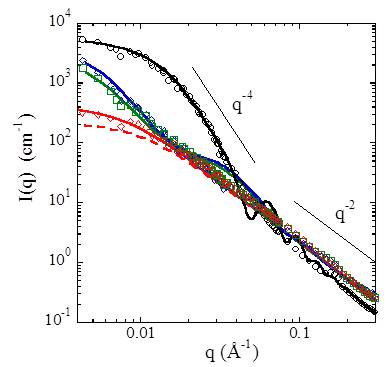
Moreover, we have investigated the failure of the zero-average contrast method to measure chain conformation and observed in the literature, and proposed an explanation based on statistical effects during film formation [Macromolecules 6596, 2015]. As illustrated on the figure below, a statistical mismatch can indeed lead to the formation of an isotopically different shell, promoting shell and thus deleterious particle scattering, in particular around the smallest nanoparticles. Finally, in samples at high filler volume fraction, a slowing down of the dynamics was observed, which could be related to the formation of glassy layers on the nanoparticle surface, as found in another system [Soft Matter 4090, 2012]. Progress on these topics has been published in an invited review recently[Cocis 293, 2015].
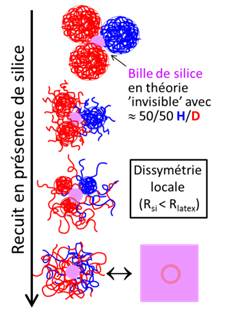
2. Structure and dynamics of simplified industrial nanocomposites :
Progress in the formulation of industrial nanocomposites has been obtained in the framework of a CIFRE-PhD with Michelin. It is important to realize the large number of ingredients in real materials, and we have therefore formulated a simplified industrial nanocomposite made by mixing of polymer and silica pellets with coating agent only. The structural and rheological analysis has led to a cover paper in Macromolecules [Macromol 317, 2013]. It is based on a combination of a statistical TEM analysis, numerical simulations of structure factors, and SAXS.
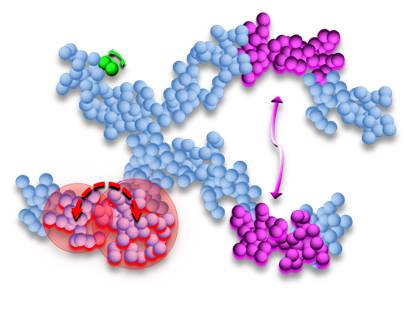
The multi-scale structure of small silica beads (≈10 nm), aggregated in clusters (R≈40 nm) of compacity 35%, and building up a fractal superstructure (see above illustration), has been characterized as a function of silica concentration, and found to agree with the mechanical properties.
Our methodological approach to characterize aggregate structure of filler is summarized in the figure below. Starting from a quantitative analysis of aggregate volumes in TEM pictures, the inter-aggregate structure factor is measured by SAXS, and interpreted using computer simulations. As a final result, both aggregate size and mass (and thus density, also termed compacity) can be determined. These findings have been cross-checked in an independent manner, by suppressing the influence of the structure factor by swelling of the samples, and measuring only the form factor of aggregates[Faraday Discussions 295, 2016]. This study confirms that aggregates remain virtually unchanged when the filler volume fraction is increased, but decrease in size and mass when grafting is introduced.
This approach has been generalized to understand the impact of matrix composition, in particular in presence of grafting polymer units [Macromol 6621, 2013], and the effect has been studied for different chain masses (40 to 280 kg/mol) [soft matter 2014]. In this article, a general model for aggregate formation during the mixing process is also proposed and confronted to experimental results. The grafting density has been identified as the unique structure-determining parameter, as shown in the second figure, where two sample with strongly differing chain mass are seen to have equivalent silica microstructures.

3. Large scale re-organizations probed via dynamics (broadband dielectric spectroscopy, BDS)
The network of aggregates being the source of the mechanical properties of nanocomposites, we have also shown that the observed microstructure is compatible with mechanical reinforcement, as shown in the figure below (left) where one sees that the rheological response is shifted as grafting is introduced (which in turn modifies the structure, see above). In parallel, we have evidenced a new interfacial polarization process using BDS [PCCP 1660, 2014]. This process has been found to be a precise probe for the characterization of large-scale structural reorganization of filler aggregates, and in particular of percolation of aggregates forming the network branches. The dielectric force follows the same behavior at the percolation threshold as rheology and ionic conductivity. In the graph on the right (below), the strong and concomitant decrease of ionic conductivity and the dielectric force of the new process – termed MWS – as a function of increasing chain grafting is shown [Polymer 131, 2015]. This effect corresponds thus to a depercolation of aggregates, in line with the shift in rheology to higher volume fractions upon grafting. Finally, all our findings on simplified industrial nanocomposites have been published in an invited feature article [EPJ 2016].
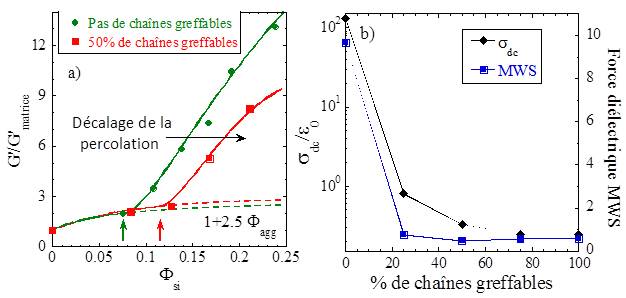
Simplified industrial nanocomposites. (left) MMechanical reinforcement at 60 Hz for increasing silica volume fraction. The percolation thresholds are indicated by arrows. (right) Ionic conductivity at 120°C compared to average of dielectric force of the interfacial polarization process (MWS) for a silica volume fraction of 8.5%v.
- Tuning structure and rheology of silica-latex nanocomposites with the molecular weight of matrix chains : a coupled SAXS-TEM-simulation approach, Amélie Banc, Anne-Caroline Genix, Mathieu Chirat, Christelle Dupas, Sylvain Caillol, Michael Sztucki, Julian Oberdisse, Macromolecules, 2014, 47 (9), pp 3219–3230
- Mechanism of aggregate formation in simplified industrial silica styrene-butadiene nanocomposites : effect of chain mass and grafting on rheology and structure, Guilhem P. Baeza, Anne-Caroline Genix, Christophe Degrandcourt, Jérémie Gummel, Marc Couty, Julian Oberdisse, Soft Matter, 2014, 10, 6686-6695.
- A high-temperature dielectric process as a probe of large-scale silica filler structure in simplified industrial nanocomposites, Guilhem P. Baeza, Julian Oberdisse, Angel Alegria, Marc Couty, Anne-Caroline Genix, Physical Chemistry Chemical Physics, 2015, 17, 1660-1666
- Depercolation of aggregates upon polymer grafting in simplified industrial nanocomposites studied with dielectric spectroscopy, G. P. Baeza, J. Oberdisse, A. Alegria, K. Saalwächter, M. Couty and Anne-Caroline Genix, Polymer 2015, 73, 131-138.
- Origin of small-angle scattering from contrast-matched nanoparticles : A study of chain and filler structure in polymer nanocomposites, Amélie Banc, Anne-Caroline Genix, Christelle Dupas, Michael Sztucki, Ralf Schweins, Marie-Sousai Appavou, Julian Oberdisse, Macromolecules 2015, 48, 6596−6605.
- Structure and dynamics of polymer nanocomposites studied by X-ray and neutron scattering techniques, Anne-Caroline Genix and Julian Oberdisse, Current Opinion in colloid and interface science (invited review article), 2015, 20 (4), 293-303.
- Revealing nanocomposite filler structures by swelling and small-angle X-ray scattering, Guilhem P. Baeza, Anne-Caroline Genix, Nathalie Paupy-Peyronnet, Christophe Degrandcourt, Marc Couty, and Julian Oberdisse, Faraday Discussions 2016, 186, 295-309.
- Recent advances in structural and dynamical properties of simplified industrial nanocomposites, A.C. Genix, G. P. Baeza, J. Oberdisse, European Polymer Journal 2016 (invited feature article, cover article), 85, 605-619.
4. Structural rearrangements of filler nanoparticles in polymer nanocomposites studied by light scattering
Diffusing wave spectroscopy (DWS) is used to follow the structural relaxation of polymer nanocomposites under strain with time, for different strain histories, see picture of the set-up below. In parallel, macroscopic measurement of stress in the sample using a force transducer gives insight into the rheological properties of the nanocomposites. While light scattering gives access to local rearrangements on the scale of individual filler nanoparticles via the decay of the intensity correlation functions, the total rheological response of the evolving filler network and the polymer matrix contributes to the rheology. The coupling of the techniques should thus allow to correlate microscopic reorganization with macroscopic properties.
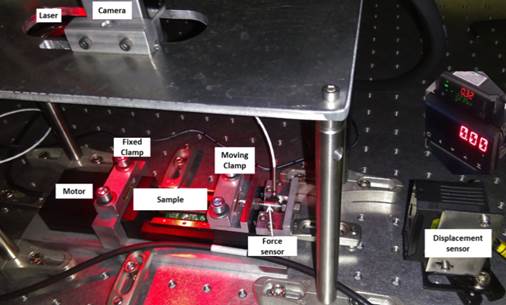
5. AFM imaging of polymer nanocomposites
AFM phase imaging mode has been shown to allow for detection and depth measurements of buried hard nanoparticles in soft polymer for depth down to around 100 nm. In situ phase AFM measurements on loaded samples (during loading and relaxation steps) and analyses of the displacement fields through adapted digital image correlation techniques, are performed to follow the evolution of the filler dispersion with deformation. This approach will be led in parallel to diffusing-wave light scattering techniques. One may also note that AFM is also used for other complex materials in our group, including the mechanics of bio-composites (starchy endosperm of wheat), with mechanical measurement at the nanoscale by AFM using nano-scratch and contact resonance (click !).
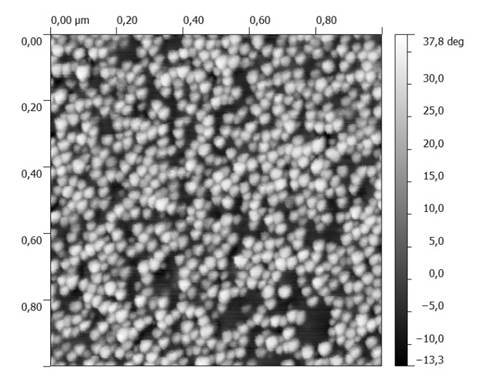
Figure. AFM phase image of silica nanoparticles inside a latex polymer. Contrast is related to the depth of silica particle.









